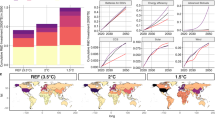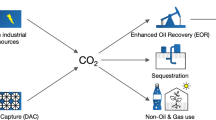Abstract
Increasing the development and diffusion of climate change mitigation technologies on a global scale is critical to reaching net-zero emissions. We have analysed over a quarter of a million high-value inventions in all major climate change mitigation technologies patented from 1995 to 2017 by inventors located in 170 countries. Our analysis shows an annual growth rate of 10% from 1995 to 2012 in these high-value inventions. Yet, from 2013 to 2017, the growth rate of these inventions fell by around 6% annually, likely driven by declining fossil fuel prices, low carbon prices and increasing technological maturity for some technologies, such as solar photovoltaics. Invention has remained highly concentrated geographically over the past decade, with inventors in Germany, Japan and the United States accounting for more than half of global inventions, and the top ten countries for almost 90%. Except for inventors in China, most middle-income economies have not caught up and remain less specialized in low-carbon technologies than high-income economies.
This is a preview of subscription content, access via your institution
Access options
Access Nature and 54 other Nature Portfolio journals
Get Nature+, our best-value online-access subscription
$29.99 / 30 days
cancel any time
Subscribe to this journal
Receive 12 digital issues and online access to articles
$119.00 per year
only $9.92 per issue
Buy this article
- Purchase on Springer Link
- Instant access to full article PDF
Prices may be subject to local taxes which are calculated during checkout







Similar content being viewed by others
Data availability
The data (PATSTAT, Autumn 2019)9 used in this research were purchased from the EPO. The contractual agreement restricts public posting of data sets containing information on individual patents. However, the aggregate data can be found on GitHub at https://github.com/SimonTouboul/ClimateMitig_Innov_NatureEnergy. Source data are provided with this paper.
Code availability
The code used in this analysis can be found on GitHub at https://github.com/SimonTouboul/ClimateMitig_Innov_NatureEnergy.
References
Viñuales, J. E. The Paris Climate Agreement: An Initial Examination C-EENRG Working Paper No. 9 (Cambridge Centre for Environment, Energy and Natural Resource Governance, Univ. of Cambridge, 2015).
Energy Technology Perspectives (IEA, 2020); https://doi.org/10.1787/9789264109834-en
Accelerating the Energy Transition through Innovation (International Renewable Energy Agency, 2017).
Probst, B., Anatolitis, V., Kontoleon, A. & Anadón, L. D. The short-term costs of local content requirements in the Indian solar auctions. Nat. Energy 5, 842–850 (2020).
Dechezleprêtre, A., Glachant, M., Haščič, I., Johnstone, N. & Ménière, Y. Invention and transfer of climate change-mitigation technologies: a global analysis. Rev. Environ. Econ. Policy 5, 109–130 (2011).
Renewables 2020 Global Status Report (REN21, 2020).
Huenteler, J. International support for feed-in tariffs in developing countries—a review and analysis of proposed mechanisms. Renew. Sustain. Energy Rev. 39, 857–873 (2014).
Cames, M. et al. How additional is the Clean Development Mechanism? Report No. CLlMA.B.3/SERl2013/0026r (DG Clima, 2016).
PATSTAT 2019 Autumn Edition (EPO, 2019); https://www.epo.org/searching-for-patents/business/patstat.html
Finding Sustainable Technologies in Patents (EPO, 2013).
De Rassenfosse, G., Dernis, H., Guellec, D., Picci, L. & Van Pottelsberghe De La Potterie, B. The worldwide count of priority patents: a new indicator of inventive activity. Res. Policy 42, 720–737 (2013).
Harhoff, D., Narin, F., Scherer, F. M. & Vopel, K. Citation frequency and the value of patented inventions. Rev. Econ. Stat. 81, 511–515 (1999).
Dechezleprêtre, A., Ménière, Y. & Mohnen, M. International patent families: from application strategies to statistical indicators. Scientometrics 111, 793–828 (2017).
Lanjouw, J. O. & Mody, A. Innovation and the international diffusion of environmentally responisve technology. Res. Policy 25, 549–571 (1996).
Park, W. G. On patenting costs. WIPO J. Anal. Intellect. Prop. Issues 2, 33–48 (2010).
Global CO2 Emissions in 2019 (IEA, 2019); https://www.iea.org/articles/global-co2-emissions-in-2019
Global Energy Review (IEA, 2021).
What is the Kyoto Protocol? (UNFCCC, 2021; accessed 7 July 2021); https://unfccc.int/kyoto_protocol
Popp, D. Induced innovation and energy prices. Am. Econ. Rev. 92, 160–180 (2002).
Calel, R. & Dechezleprêtre, A. Environmental policy and directed technological change: evidence from the European carbon market. Rev. Econ. Stat. 98, 173–191 (2016).
Acemoglu, D., Aghion, P., Barrage, L. & Hemous, D. Climate Change, Directed Innovation, and Energy Transition: The Long-Run Consequences of the Shale Gas Revolution Meeting Paper No. 1302 (Society for Economic Dynamics, 2019).
State and Trends of Carbon Pricing 2021 (The World Bank, 2021); https://doi.org/10.1596/978-1-4648-1728-1
Effective Carbon Rates 2021 (OECD, 2021).
Bayer, P. & Aklin, M. The European Union emissions trading system reduced CO2 emissions despite low prices. Proc. Natl Acad. Sci. USA 117, 8804–8812 (2020).
Summary of Auction Settlement Prices and Results May 2021 (California Air Resources Board, 2021).
Daily Carbon Prices (EMBER, 2021; accessed 1 July 2021); https://ember-climate.org/data/carbon-price-viewer/
2030 Climate & Energy Framework (European Commission, 2021; accessed 8 July 2021); https://ec.europa.eu/clima/policies/strategies/2030_en
Margolis, R. M. & Kammen, D. M. Evidence of under-investment in energy R&D in the United States and the impact of Federal policy. Energy Policy 27, 575–584 (1999).
Popp, D. Economic analysis of scientific publications and implications for energy research and development. Nat. Energy 1, 16020 (2016).
Myslikova, Z. & Gallagher, K. S. Mission Innovation is mission critical. Nat. Energy 5, 732–734 (2020).
Popp, D., Pless, J., Hascic, I. & Johnstone, N. Innovation and Entrepreneurship in the Energy Sector Working Paper No. 27145 (NBER, 2020).
Patents and the Energy Transition: Global Trends in Clean Energy Technology Innovation (IEA, 2021).
Hart, D. M. The Impact of China’s Production Surge on Innovation in the Global Solar Photovoltaics Industry (Innovation Technology & Innovation Foundation, 2020).
Carvalho, M. D., Dechezleprêtre, A. & Glachant, M. Understanding the Dynamics of Global Value Chains for Solar Photovoltaic Technologies Economic Research Working Paper No. 40 (World Intellectual Property Organization, 2017).
Sinke, W. C. Development of photovoltaic technologies for global impact. Renew. Energy 138, 911–914 (2019).
Weinold, M., Kolesnikov, S. & Anadon, L. D. Quantifying the impact of performance improvements and cost reductions from 20 years of light-emitting diode manufacturing. In Proc. SPIE 11706 Light-Emitting Devices, Materials, and Applications XXV (eds Strassburg, M. et al.) 34 (SPIE, 2021); https://doi.org/10.1117/12.2577591
Policies for a Climate-Neutral Industry. Lessons from the Netherlands (OECD, 2021).
IEA 20 Years of Carbon Capture and Storage (OECD, 2016); https://doi.org/10.1787/9789264267800-en
Reiner, D. M. Learning through a portfolio of carbon capture and storage demonstration projects. Nat. Energy 1, 15011 (2016).
CO2 Reduction Through Storage Beneath the North Sea (Porthos, 2020); https://www.porthosco2.nl/en/
Northern Lights https://northernlightsccs.com/en/about (2020).
Share of Activity on Electric Trains for Selected Countries and Regions, 1995-2016 (IEA, 2019; accessed 7 July 2021); https://www.iea.org/data-and-statistics/charts/share-of-activity-on-electric-trains-for-selected-countries-and-regions-1995-2016
Glachant, M., Dussaux, D., Paristech, M. & Dechezleprêtre, A. Promoting the International Transfer of Low-Carbon Technologies: Evidence and Policy Challenges (Commissariat général à la stratégie et à la prospective (French Center for Policy Planning), 2013); https://personal.lse.ac.uk/dechezle/Promoting_the_international_transfer_of_low_carbon_techs.pdf
Keller, W. International technology diffusion. J. Econ. Lit. 42, 752–782 (2004).
Glachant, M. & Dechezleprêtre, A. What role for climate negotiations on technology transfer? Clim. Policy 17, 962–981 (2017).
Fact Sheet: EU-China Automobile Trade (ACEA, 2019); https://www.acea.be/news/article/fact-sheet-eu-china-automobile-trade
Luderer, G. et al. The economics of decarbonizing the energy system—results and insights from the RECIPE model intercomparison. Clim. Change 114, 9–37 (2012).
Grubler, A. et al. A low energy demand scenario for meeting the 1.5 °C target and sustainable development goals without negative emission technologies. Nat. Energy 3, 515–527 (2018).
The Sustainability Transition in Europe in an Age of Demographic and Technological Change (European Environment Agency, 2019).
The Role of Technology and Innovation in Inclusive and Sustainable Industrial Development (UNIDO, 2016); https://doi.org/10.18356/1b194e1c-en
Angelucci, S., Hurtado-Albir, F. J. & Volpe, A. Supporting global initiatives on climate change: the EPO’s “Y02-Y04S” tagging scheme. World Pat. Inf. 54, S85–S92 (2018).
Zephyr (Bureau van Dijk, accessed 23 March 2018); https://www.bvdinfo.com/en-gb/our-products/data/economic-and-ma/zephyr
UN Comtrade Database (United Nations, accessed 1 March 2021); http://comtrade.un.org/
Fleming, L., Greene, H., Li, G., Marx, M. & Yao, D. Government-funded research increasingly fuels innovation. Science 364, 1139–1141 (2019).
Popp, D. They don’t invent them like they used to: an examination of energy patent citations over time. Econ. Innov. New Technol. 15, 753–776 (2006).
Dechezleprêtre, A., Martin, R. & Mohnen, M. Knowledge Spillovers from Clean and Dirty Technologies: A Patent Citation Analysis Grantham Research Institute on the Environment Working Paper No. 151 (Centre for Climate Change Economics and Policy, 2013).
Cohen, W., Nelson, R. & Walsh, J. Protecting Their Intellectual Assets: Appropriability Conditions and Why U.S. Manufacturing Firms Patent (or Not) (NBER, 2000); https://doi.org/10.3386/w7552
Griliches, Z. Patent Statistics as Economic Indicators: A Survey (NBER, 1990); https://doi.org/10.3386/w3301
Svensson, R. Commercialization, renewal, and quality of patents. Econ. Innov. New Technol. 21, 175–201 (2012).
Serajuddin, U. & Hamadeh, N. New World Bank Country Classifications by Income Level: 2020-2021. World Bank Blogs https://blogs.worldbank.org/opendata/new-world-bank-country-classifications-income-level-2020-2021 (2020).
Dussaux, D., Dechezleprêtre, A. & Glachant, M. Intellectual Property Rights Protection and the International Transfer of Low-Carbon Technologies Grantham Research Institute on the Environment Working Paper No. 323 (Centre for Climate Change Economics and Policy, 2018).
Mealy, P. & Teytelboym, A. Economic complexity and the green economy. Res. Policy https://doi.org/10.1016/j.respol.2020.103948 (2020).
World Bank Commodity Price Data (World Bank, 2021); https://thedocs.worldbank.org/en/doc/5d903e848db1d1b83e0ec8f744e55570-0350012021/related/CMO-Historical-Data-Annual.xlsx
Acknowledgements
B.P. thanks F. Scheifele for support with trade data, and E. Petkov and C. Knoeri for insights on innovation in the building sector. A.D. acknowledges support from the Grantham Research Institute on Climate Change and the Environment, at the London School of Economics, and the ESRC Centre for Climate Change Economics and Policy (CCCEP) (ref. ES/R009708/1).
Author information
Authors and Affiliations
Contributions
All authors developed the research idea. S.T. conducted the empirical analysis with support from B.P., B.P. analysed and visualized the data and wrote the manuscript with support from S.T., while M.G. and A.D. edited the final draft.
Corresponding author
Ethics declarations
Competing interests
The authors declare no competing interests.
Additional information
Peer review information Nature Energy thanks Kelly Gallagher, Anna Goldstein and Massimiliano Mazzanti for their contribution to the peer review of this work.
Publisher’s note Springer Nature remains neutral with regard to jurisdictional claims in published maps and institutional affiliations.
Supplementary information
Supplementary Information
Supplementary Figs. 1–9, Tables 1–5 and Note 1.
Source data
Source Data Fig. 1
Underlying data for Fig. 1.
Source Data Fig. 2
Underlying data for Fig. 2.
Source Data Fig. 3
Underlying data for Fig. 3.
Source Data Fig. 4
Underlying data for Fig. 4.
Source Data Fig. 5
Underlying data for Fig. 5.
Source Data Fig. 6
Underlying data for Fig. 6.
Source Data Fig. 7
Underlying data for Fig. 7.
Rights and permissions
About this article
Cite this article
Probst, B., Touboul, S., Glachant, M. et al. Global trends in the invention and diffusion of climate change mitigation technologies. Nat Energy 6, 1077–1086 (2021). https://doi.org/10.1038/s41560-021-00931-5
Received:
Accepted:
Published:
Issue Date:
DOI: https://doi.org/10.1038/s41560-021-00931-5
This article is cited by
-
Global trend of methane abatement inventions and widening mismatch with methane emissions
Nature Climate Change (2024)
-
Tracking artificial intelligence in climate inventions with patent data
Nature Climate Change (2023)
-
Future reductions of China’s transport emissions impacted by changing driving behaviour
Nature Sustainability (2023)
-
Clean cooking technologies, information, and communication technology and the environment
Environmental Science and Pollution Research (2023)
-
The case for carbon leakage and border adjustments: where do economists stand?
Environmental Economics and Policy Studies (2023)



